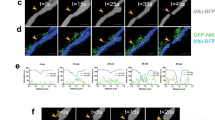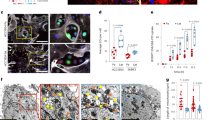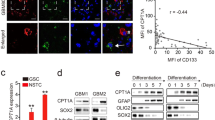Abstract
Brain tumor initiating cells (BTICs) co-opt the neuronal high affinity glucose transporter, GLUT3, to withstand metabolic stress. We investigated another mechanism critical to brain metabolism, mitochondrial morphology, in BTICs. BTIC mitochondria were fragmented relative to non-BTIC tumor cell mitochondria, suggesting that BTICs increase mitochondrial fission. The essential mediator of mitochondrial fission, dynamin-related protein 1 (DRP1), showed activating phosphorylation in BTICs and inhibitory phosphorylation in non-BTIC tumor cells. Targeting DRP1 using RNA interference or pharmacologic inhibition induced BTIC apoptosis and inhibited tumor growth. Downstream, DRP1 activity regulated the essential metabolic stress sensor, AMP-activated protein kinase (AMPK), and targeting AMPK rescued the effects of DRP1 disruption. Cyclin-dependent kinase 5 (CDK5) phosphorylated DRP1 to increase its activity in BTICs, whereas Ca2+-calmodulin-dependent protein kinase 2 (CAMK2) inhibited DRP1 in non-BTIC tumor cells, suggesting that tumor cell differentiation induces a regulatory switch in mitochondrial morphology. DRP1 activation correlated with poor prognosis in glioblastoma, suggesting that mitochondrial dynamics may represent a therapeutic target for BTICs.
This is a preview of subscription content, access via your institution
Access options
Subscribe to this journal
Receive 12 print issues and online access
$209.00 per year
only $17.42 per issue
Buy this article
- Purchase on Springer Link
- Instant access to full article PDF
Prices may be subject to local taxes which are calculated during checkout








Similar content being viewed by others
References
Stupp, R. et al. Effects of radiotherapy with concomitant and adjuvant temozolomide versus radiotherapy alone on survival in glioblastoma in a randomised phase III study: 5-year analysis of the EORTC-NCIC trial. Lancet Oncol. 10, 459–466 (2009).
Brennan, C.W. et al. The somatic genomic landscape of glioblastoma. Cell 155, 462–477 (2013).
Frattini, V. et al. The integrated landscape of driver genomic alterations in glioblastoma. Nat. Genet. 45, 1141–1149 (2013).
Singh, S.K. et al. Identification of human brain tumour initiating cells. Nature 432, 396–401 (2004).
Galli, R. et al. Isolation and characterization of tumorigenic, stem-like neural precursors from human glioblastoma. Cancer Res. 64, 7011–7021 (2004).
Hemmati, H.D. et al. Cancerous stem cells can arise from pediatric brain tumors. Proc. Natl. Acad. Sci. USA 100, 15178–15183 (2003).
Gage, F.H. & Temple, S. Neural stem cells: generating and regenerating the brain. Neuron 80, 588–601 (2013).
Bao, S. et al. Glioma stem cells promote radioresistance by preferential activation of the DNA damage response. Nature 444, 756–760 (2006).
Bao, S. et al. Stem cell-like glioma cells promote tumor angiogenesis through vascular endothelial growth factor. Cancer Res. 66, 7843–7848 (2006).
Günther, H.S. et al. Glioblastoma-derived stem cell-enriched cultures form distinct subgroups according to molecular and phenotypic criteria. Oncogene 27, 2897–2909 (2008).
Sarkar, S. et al. Therapeutic activation of macrophages and microglia to suppress brain tumor-initiating cells. Nat. Neurosci. 17, 46–55 (2014).
Zhou, B.B. et al. Tumour-initiating cells: challenges and opportunities for anticancer drug discovery. Nat. Rev. Drug Discov. 8, 806–823 (2009).
Ward, P.S. & Thompson, C.B. Metabolic reprogramming: a cancer hallmark even Warburg did not anticipate. Cancer Cell 21, 297–308 (2012).
Yan, H. et al. IDH1 and IDH2 mutations in gliomas. N. Engl. J. Med. 360, 765–773 (2009).
Turcan, S. et al. IDH1 mutation is sufficient to establish the glioma hypermethylator phenotype. Nature 483, 479–483 (2012).
Marin-Valencia, I. et al. Analysis of tumor metabolism reveals mitochondrial glucose oxidation in genetically diverse human glioblastomas in the mouse brain in vivo. Cell Metab. 15, 827–837 (2012).
Vlashi, E. et al. Metabolic state of glioma stem cells and nontumorigenic cells. Proc. Natl. Acad. Sci. USA 108, 16062–16067 (2011).
Kathagen, A. et al. Hypoxia and oxygenation induce a metabolic switch between pentose phosphate pathway and glycolysis in glioma stem-like cells. Acta Neuropathol. 126, 763–780 (2013).
Flavahan, W.A. et al. Brain tumor initiating cells adapt to restricted nutrition through preferential glucose uptake. Nat. Neurosci. 16, 1373–1382 (2013).
Janiszewska, M. et al. Imp2 controls oxidative phosphorylation and is crucial for preserving glioblastoma cancer stem cells. Genes Dev. 26, 1926–1944 (2012).
Ochocki, J.D. & Simon, M.C. Nutrient-sensing pathways and metabolic regulation in stem cells. J. Cell Biol. 203, 23–33 (2013).
Archer, S.L. Mitochondrial dynamics–mitochondrial fission and fusion in human diseases. N. Engl. J. Med. 369, 2236–2251 (2013).
Chen, H. et al. Mitofusins Mfn1 and Mfn2 coordinately regulate mitochondrial fusion and are essential for embryonic development. J. Cell Biol. 160, 189–200 (2003).
Todd, L.R., Gomathinayagam, R. & Sankar, U. A novel Gfer-Drp1 link in preserving mitochondrial dynamics and function in pluripotent stem cells. Autophagy 6, 821–822 (2010).
Todd, L.R. et al. Growth factor erv1-like modulates Drp1 to preserve mitochondrial dynamics and function in mouse embryonic stem cells. Mol. Biol. Cell 21, 1225–1236 (2010).
Kashatus, D.F. et al. RALA and RALBP1 regulate mitochondrial fission at mitosis. Nat. Cell Biol. 13, 1108–1115 (2011).
Zhao, J. et al. Mitochondrial dynamics regulates migration and invasion of breast cancer cells. Oncogene 32, 4814–4824 (2013).
Thomas, K.J. & Jacobson, M.R. Defects in mitochondrial fission protein dynamin-related protein 1 are linked to apoptotic resistance and autophagy in a lung cancer model. PLoS ONE 7, e45319 (2012).
Guido, C. et al. Mitochondrial fission induces glycolytic reprogramming in cancer-associated myofibroblasts, driving stromal lactate production, and early tumor growth. Oncotarget 3, 798–810 (2012).
Palorini, R. et al. Oncogenic K-ras expression is associated with derangement of the cAMP/PKA pathway and forskolin-reversible alterations of mitochondrial dynamics and respiration. Oncogene 32, 352–362 (2013).
Rehman, J. et al. Inhibition of mitochondrial fission prevents cell cycle progression in lung cancer. FASEB J. 26, 2175–2186 (2012).
Wan, Y.Y. et al. Involvement of Drp1 in hypoxia-induced migration of human glioblastoma U251 cells. Oncol. Rep. 32, 619–626 (2014).
Kasahara, A., Cipolat, S., Chen, Y., Dorn, G.W. II & Scorrano, L. Mitochondrial fusion directs cardiomyocyte differentiation via calcineurin and Notch signaling. Science 342, 734–737 (2013).
Tanaka, A. & Youle, R.J. A chemical inhibitor of DRP1 uncouples mitochondrial fission and apoptosis. Mol. Cell 29, 409–410 (2008).
Gharanei, M., Hussain, A., Janneh, O. & Maddock, H. Attenuation of doxorubicin-induced cardiotoxicity by mdivi-1: a mitochondrial division/mitophagy inhibitor. PLoS ONE 8, e77713 (2013).
Eyler, C.E. et al. Glioma stem cell proliferation and tumor growth are promoted by nitric oxide synthase-2. Cell 146, 53–66 (2011).
Cheng, L. et al. Glioblastoma stem cells generate vascular pericytes to support vessel function and tumor growth. Cell 153, 139–152 (2013).
Taguchi, N., Ishihara, N., Jofuku, A., Oka, T. & Mihara, K. Mitotic phosphorylation of dynamin-related GTPase Drp1 participates in mitochondrial fission. J. Biol. Chem. 282, 11521–11529 (2007).
Cribbs, J.T. & Strack, S. Reversible phosphorylation of Drp1 by cyclic AMP-dependent protein kinase and calcineurin regulates mitochondrial fission and cell death. EMBO Rep. 8, 939–944 (2007).
Son, M.J., Woolard, K., Nam, D.H., Lee, J. & Fine, H.A. SSEA-1 is an enrichment marker for tumor-initiating cells in human glioblastoma. Cell Stem Cell 4, 440–452 (2009).
Sato, A. et al. Glioma-initiating cell elimination by metformin activation of FOXO3 via AMPK. Stem Cells Transl. Med. 1, 811–824 (2012).
Han, X.J. et al. CaM kinase I alpha-induced phosphorylation of Drp1 regulates mitochondrial morphology. J. Cell Biol. 182, 573–585 (2008).
Eramo, A. et al. Chemotherapy resistance of glioblastoma stem cells. Cell Death Differ. 13, 1238–1241 (2006).
Anido, J. et al. TGF-β receptor inhibitors target the CD44(high)/Id1(high) glioma-initiating cell population in human glioblastoma. Cancer Cell 18, 655–668 (2010).
Catania, A. et al. Expression and localization of cyclin-dependent kinase 5 in apoptotic human glioma cells. Neuro-oncol. 3, 89–98 (2001).
Gao, C. et al. Cdk5 mediates changes in morphology and promotes apoptosis of astrocytoma cells in response to heat shock. J. Cell Sci. 114, 1145–1153 (2001).
Liu, R. et al. Cdk5-mediated regulation of the PIKE-A-Akt pathway and glioblastoma cell invasion. Proc. Natl. Acad. Sci. USA 105, 7570–7575 (2008).
Lagadinou, E.D. et al. BCL-2 inhibition targets oxidative phosphorylation and selectively eradicates quiescent human leukemia stem cells. Cell Stem Cell 12, 329–341 (2013).
Guo, X. et al. Inhibition of mitochondrial fragmentation diminishes Huntington's disease-associated neurodegeneration. J. Clin. Invest. 123, 5371–5388 (2013).
Gilbert, M.R. et al. Autophagy and oxidative stress in gliomas with IDH1 mutations. Acta Neuropathol. 127, 221–233 (2014).
Acknowledgements
We appreciate flow cytometry assistance from C. Shemo and S. O'Bryant, and the tissue provided by M. McGraw, the Cleveland Clinic Foundation Tissue Procurement Service and A.E. Sloan (University Hospitals). I. Nakano (Ohio State University) kindly provided the IN528 model. We thank members of the Rich laboratory for critical reading of the manuscript and discussions. We thank A. Janocha for help with using the Seahorse XF Extracellular Flux Analyzer. Special thanks to D. Napier for her histologic expertise. Finally, we thank our funding sources: US National Institutes of Health grants CA154130, CA169117, CA171652, NS087913, NS089272 (J.N.R.), and CA155764, 2P20 RR020171 COBRE pilot grant (C.M.H.) and NS070315 (S.B.); the Research Programs Committees of Cleveland Clinic (J.N.R.); and the James S. McDonnell Foundation (J.N.R.). C.M.H. was supported by the Peter and Carmen Lucia Buck Training Program in Translational Clinical Oncology and the University of Kentucky College of Medicine Physician Scientist Program. The Markey Biospecimen and Tissue Procurement (BSTP) Shared Resource Facility facilitated the construction of tissue microarrays and immunohistochemical studies. The BSTP Shared Resource Facility is supported by the University of Kentucky Markey Cancer Center (P30CA177558).
Author information
Authors and Affiliations
Contributions
Q.X. and J.N.R. designed the experiments, analyzed data and prepared the manuscript. Q.X., Q.W., K.Y.,W.Z., S.M.D., Z.H., X.F. and A.N.F. performed the experiments. W.A.F. and Y.S. performed database analyses. C.M.H. performed pathologic analyses. S.B. and D.F.K. provided scientific input and helped to edit the manuscript.
Corresponding author
Ethics declarations
Competing interests
The authors declare no competing financial interests.
Integrated supplementary information
Supplementary Figure 1 Total protein levels of mitochondrial dynamic mediators are not differentially expressed by brain tumor initiating cells.
Total levels of mitochondrial dynamic regulators do not differ within the glioma hierarchy. Immunoblot analysis of DRP1, MFN1, MFN2, and OPA1 in brain tumor initiating cells (BTICs) and non-BTICs isolated from multiple patient-derived glioblastoma xenografts (4302, 387, 3565, and IN528). Images were cropped for presentation. Full-length blots are presented in Supplementary Fig. 12.
Supplementary Figure 2 DRP1 targeting has less minimal effects on non-brain tumor initiating cells and neuroprogenitors.
a, b. Effects of DRP1 knockdown with two independent shRNA constructs on cell proliferation in 387 non-brain tumor initiating cells (non-BTICs) and the ENSA human neural progenitor cell (NPC) line.
Supplementary Figure 3 Mdivi-1 treatment induces tubular mitochondrial morphology.
a. Immunofluorescent staining of the mitochondrial marker TOM20 in 387 and 3565 BTICs treated with DMSO or Mdivi-1. Data are represented as mean ± s.e.m. (387: fragmented, p = 0.0032; tubular, p = 0.0010. 3565: fragmented, p = 0.0092; tubular, p = 0.0015 by Student’s t-test; n = 3). b. Analysis of tumor mitochondrial morphology treated in vivo with Mdivi-1. 16 days after tumor implantation, immunocompromised mice bearing orthotopic 387 BTICs (3 × 105 cells/animal) were treated with Midivi-1 (2.5 mg/kg) or DMSO vehicle control. Mitochondria morphology of brain tumor tissue was assessed by Transmission electron microscopy. At least 30 mitochondria were analyzed per experiment. Scale bars indicate 1 µm. Data are presented as mean ± s.e.m. (p = 0.0353 by Student’s t-test; n = 3).
Supplementary Figure 4 Activation of AMPK inhibits proliferation and promotes apoptosis in brain tumor initiating cells.
a. Continuous measurement of oxygen consumption rate (OCR) of BTICs (T387) expressing non-targeting (NT) control shRNA, shDrp1#1, or shDrp1#2 was performed with the Seahorse system. Data are shown as mean ± s.e.m. (shDrp1#1: p = 0.0022; shDrp1#2: p = 0.0012 by Student’s t-test; n = 3). b. Effects of treatment with the selective AMPK activator AICAR on cell proliferation in 387 brain tumor-initiating cells (BTICs). Data are shown as mean ± s.e.m. (shDrp1#1: p = 0.0022; shDrp1#2: p = 0.0012 by repeated measures ANOVA; n = 3). c. Immunoblot shows increased cleaved PARP following AICAR treatment of 387 BTICs. Images were cropped for presentation. Full-length blots are presented in Supplementary Fig. 12.
Supplementary Figure 5 Cyclin-dependent kinase 5 (CDK5) inhibition reprograms BTIC mitochondrial morphology.
a. Immunofluorescent staining of the mitochondrial marker TOM20 in 387 and 3565 BTICs treated with DMSO, Roscovitine or BMS-265246. b. Data are represented as mean ± s.e.m. (387: roscovitine: fragmented, p = 0.0041; tubular, p = 0.0010. 3565, roscovitine: fragmented, p = 0.0049; tubular: p = 0.0017 by Student’s t-test; n = 3).
Supplementary Figure 6 Cyclin-dependent kinase 5 (CDK5) maintains brain tumor initiating cells (BTICs).
a. Effects of CDK5 knockdown with two independent lentiviral shRNA constructs on cell proliferation in two BTIC models. Data are represented as mean ± s.e.m. (387, p < 0.0001; 3565, p < 0.0001 by repeated measures ANOVA; n = 4). b. In vitro extreme limiting dilution assays (ELDA) to single cells demonstrate that knockdown of CDK5 in two BTIC models decreases the frequency of tumorsphere formation (387: p = 3.4 × 10−13; 3565: p = 2.2 × 10−8 by ANOVA). c. Proposed model of CDK5 regulation of DRP1 in BTICs.
Supplementary Figure 7 Ca2+–calmodulin-dependent protein kinase 2 (CAMK2) inhibits DRP1 in non-brain tumor initiating cells.
a. Lysates of 387 non-brain tumor initiating cells (non-BTICs) treated with the pan-CAMK inhibitor KN93 or DMSO vehicle control were immunoblotted with the indicated antibodies. Images were cropped for presentation. Full-length blots are presented in Supplementary Fig. 12. b. Lysates of 387 NSTCs treated Autocamtide-2-Related Inhibitory Peptide (AIP), a CAMK2 specific inhibitor, or ddH2O vehicle control were immunoblotted with the indicated antibodies. c. Immunoblot analysis of CAMK1, CAMK2, stem and differentiation markers in BTICs and non-BTICs isolated from multiple patient-derived glioma xenografts (4302, 387, and 3565). d. Immunofluorescent staining of TOM20 in 387 and 3565 non-BTICs treated with AIP or ddH2O vehicle control. Data are represented as mean ± s.e.m. (387: fragmented, p = 0.0028; tubular, p = 0.0050. 3565: fragmented, p = 0.0036; tubular, p = 0.0031 by Student’s t-test; n = 3). e. Proposed model of DRP1 regulation in non-BTICs by CAMK2.
Supplementary Figure 8 Multivariate analysis of AMPK, CDK5 and CAMK2 informs poor prognosis across mixed-grade gliomas.
Analysis of REMBRANDT data indicates that low AMPK + high CDK5 + low CAMK2 mRNA expression correlates with poor glioma patient survival. Top: p < 0.0001; bottom: p = 0.0002 by log-rank analysis.
Supplementary information
Supplementary Text and Figures
Supplementary Figures 1–12 (PDF 1264 kb)
Rights and permissions
About this article
Cite this article
Xie, Q., Wu, Q., Horbinski, C. et al. Mitochondrial control by DRP1 in brain tumor initiating cells. Nat Neurosci 18, 501–510 (2015). https://doi.org/10.1038/nn.3960
Received:
Accepted:
Published:
Issue Date:
DOI: https://doi.org/10.1038/nn.3960
This article is cited by
-
CDK5: an oncogene or an anti-oncogene: location location location
Molecular Cancer (2023)
-
Cancer stem cell fate determination: mito-nuclear communication
Cell Communication and Signaling (2023)
-
Role of mitochondrial alterations in human cancer progression and cancer immunity
Journal of Biomedical Science (2023)
-
LncRNA INHEG promotes glioma stem cell maintenance and tumorigenicity through regulating rRNA 2’-O-methylation
Nature Communications (2023)
-
Mitoribosomal synthetic lethality overcomes multidrug resistance in MYC-driven neuroblastoma
Cell Death & Disease (2023)



